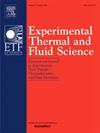Phase-locking PIV measurement of vortex–vortex interactions inside dual-slit cavity during high-intensity acoustic modulation
IF 3.3
2区 工程技术
Q2 ENGINEERING, MECHANICAL
Experimental Thermal and Fluid Science
Pub Date : 2025-03-24
DOI:10.1016/j.expthermflusci.2025.111483
引用次数: 0
Abstract
This study experimentally investigates the vortex–vortex interaction mechanism inside a dual-slit cavity structure under high-intensity external acoustic modulation. Particular attention was paid to the slit distance, which corresponded to different vortex behaviors under the combined acoustic forcing effect and wall-confinement effect. A phase-locking particle image velocimetry measurement was performed using the incident acoustic wave as a phase-determination signal. The dynamically interactive response between acoustics and vortices was accurately phase-resolved through a field-programmable gate array with a precast wave decomposition method and a hard-computation approach. Four types of interaction mechanisms (rapid vortex merging, mutually interfered vortex shedding, isolated vortex evolution, and wall-confined vortex jets, with 2, 16, 32 and 49, respectively) were classified. Subsequent analysis on their vortex trajectory, convection velocity and kinetic energy consolidate our findings on the acoustic impedance and absorption characteristics, which are significantly reduced by the wall-confinement effect, whereas the vortex-merging effect can have a positive augmentation effect. Finally, multi-scale analysis by proper orthogonal decomposition (POD) and turbulence-production theory was conducted on the interactive vortex structures. POD identified the dominant energy distribution and demonstrated that vortex merging will disrupt the independent periodic wavepacket distribution and make the energy distribution mixed. Meanwhile, the production and dissipation processes of small-scale turbulence structures were identified, accompanying with the variations of turbulence stresses by the interactive vortex structures.
高强度声调制双狭缝腔内涡涡相互作用的锁相PIV测量
实验研究了高强度外声调制下双狭缝腔内涡-涡相互作用机制。在声强迫和壁面约束作用下,狭缝距离对应着不同的涡行为。利用入射声波作为测相信号,进行了锁相粒子图像测速。通过现场可编程门阵列,采用预制波分解法和硬计算方法,对声学与涡旋的动态交互响应进行了精确相位分解。涡旋快速合并、相互干扰涡脱落、孤立涡演化和壁面受限涡射流4种相互作用机制,S∗分别为2、16、32和49。随后对它们的涡旋轨迹、对流速度和动能的分析巩固了我们对声阻抗和吸收特性的研究结果,壁面约束效应显著降低了声阻抗和吸收特性,而涡合并效应则有正增强作用。最后,利用正交分解和湍流产生理论对相互作用涡结构进行了多尺度分析。POD确定了能量的主导分布,并证明了涡旋合并会破坏独立的周期波包分布,使能量分布混合。同时,确定了小尺度湍流结构的产生和耗散过程,以及相互作用涡结构对湍流应力的影响。
本文章由计算机程序翻译,如有差异,请以英文原文为准。
求助全文
约1分钟内获得全文
求助全文
来源期刊

Experimental Thermal and Fluid Science
工程技术-工程:机械
CiteScore
6.70
自引率
3.10%
发文量
159
审稿时长
34 days
期刊介绍:
Experimental Thermal and Fluid Science provides a forum for research emphasizing experimental work that enhances fundamental understanding of heat transfer, thermodynamics, and fluid mechanics. In addition to the principal areas of research, the journal covers research results in related fields, including combined heat and mass transfer, flows with phase transition, micro- and nano-scale systems, multiphase flow, combustion, radiative transfer, porous media, cryogenics, turbulence, and novel experimental techniques.
 求助内容:
求助内容: 应助结果提醒方式:
应助结果提醒方式:


